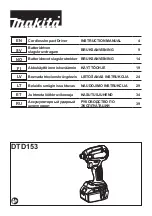
ENGLISH
30
Markings on Tool
The following pictograms are shown on the tool:
Read instruction manual before use.
DATE CODE POSITION
The date code, which also includes
the year of
manufacture, is printed into the housing surface that
forms the mounting joint between tool and battery.
Example:
2011 XX XX
Year of Manufacture
Important Safety Instructions for All
Battery Chargers
SAVE THESE INSTRUCTIONS:
This manual
contains important safety and operating instruc tions
for the DCB100 and DCB105 battery chargers.
• Before using charger, read all instructions and
cautionary markings on charger, battery pack,
and product using battery pack.
WARNING:
Shock hazard. Do not allow
any liquid to get inside charger. Electric
shock may result.
CAUTION:
Burn hazard. To reduce
the risk of injury, charge only D
E
WALT
rechargeable batteries. Other types of
batteries may burst causing personal
injury and damage.
CAUTION:
Children should be
supervised to ensure that they do not
play with the appliance.
NOTICE:
Under certain conditions, with
the charger plugged in to the power
supply, the charger can be shorted by
foreign material. Foreign materials of
a conductive nature such as, but not
limited to, grinding dust, metal chips,
steel wool, aluminum foil, or any buildup
of metallic particles should be kept away
from charger cavities. Always unplug the
charger from the power supply when
there is no battery pack in the cavity.
Unplug charger before attempting to
clean.
• DO NOT attempt to charge the battery pack
with any chargers other than the ones in
this manual.
The charger and battery pack are
specifically designed to work together.
• These chargers are not intended for
any uses other than charging D
E
WALT
rechargeable batteries.
Any other uses
may result in risk of fire, electric shock or
electrocution.
• Do not expose charger to rain or snow.
• Pull by plug rather than cord when
disconnecting charger.
This will reduce risk
of damage to electric plug and cord.
• Make sure that cord is located so that it
will not be stepped on, tripped over, or
otherwise subjected to damage or stress
.
• Do not use an extension cord unless it
is absolutely necessary.
Use of improper
extension cord could result in risk of fire,
electric shock, or electrocution.
• Do not place any object on top of charger
or place the charger on a soft surface that
might block the ventilation slots and result
in excessive internal heat.
Place the charger
in a position away from any heat source. The
charger is ventilated through slots in the top and
the bottom of the housing.
• Do not operate charger with damaged cord
or plug
— have them replaced immediately.
•
Do not operate charger if it has received
a sharp blow, been dropped, or otherwise
damaged in any way.
Take it to an authorised
service centre.
• Do not disassemble charger; take it to an
authorised service centre when service or
repair is required.
Incorrect reassembly may
result in a risk of electric shock, electrocution or
fire.
• In case of damaged power supply cord the
supply cord must be replaced immediately by
the manufacturer, its service agent or similar
qualified person to prevent any hazard.
• Disconnect the charger from the outlet
before attempting any cleaning. This will
reduce the risk of electric shock.
Removing
the battery pack will not reduce this risk.
• NEVER
attempt to connect 2 chargers together.
• The charger is designed to operate on
standard 230V household electrical power.
Do not attempt to use it on any other
voltage.
This does not apply to the vehicular
charger.
SAVE THESE INSTRUCTIONS
Chargers
The DCB100 and DCB105 chargers accept 10.8 V
Li-Ion batteries.
















































